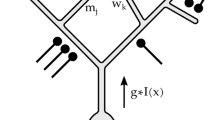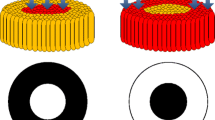Abstract
Idealized models of receptive fields (RFs) can be used as building blocks for the creation of powerful distributed computation systems. The present report concentrates on investigating the utility of collections of RFs in representing three-dimensional objects under changing viewing conditions. The main requirement in this task is that the pattern of activity of RFs vary as little as possible when the object and the camera move relative to each other. I propose a method for representing objects by RF activities, based on the observation that, in the case of rotation around a fixed axis, differences of activities of RFs that are properly situated with respect to that axis remain invariant. Results of computational experiments suggest that a representation scheme based on this algorithm for the choice of stable pairs of RFs would perform consistently better than a scheme involving random sets of RFs. The proposed scheme may be useful under object or camera rotation, both for ideal lambertian objects, and for real-world objects such as human faces.
Similar content being viewed by others
References
Aloimonos JY, Shulman D (1989) Integration of visual modules: an extension of the Marr paradigm. Academic Press, Boston
Aloimonos JY, Weiss I, Bandopadhay A (1988) Active vision. Int J Comput Vision 2:333–356
Amari S (1968) Invariant structures of signal and feature spaces in pattern recognition problems. RAAG Mem 4:553–566
Amari S (1978) Feature spaces which admit and detect invariant signal transformations. In: Proc 4th Intl Conf on Pattern Recognition, Tokyo, pp 452–456
Amari S, Maruyama M (1987) A theory on the determination of 3D motion and 3D structure from features. Spatial Vision 2:151–168
Bishop PO, Coombs JS, Henry GH (1973) Receptive fields of simple cells in the cat striate cortex. J Physiol (Lond) 231:31–60
Blinn JF (1988), Models of light reflection for computer-synthesized pictures. In: Richards W (eds) Natural computation. MIT Press, Cambridge, Mass, pp 214–223
Bülthoff HH, Edelman S (1992) Psychophysical support for a 2-D view interpolation theory of object recognition. Proc Natl Acad Sci USA 89:60–64
Dawis S, Shapley R, Kaplan E, Tranchina D (1984) The receptive field organization of X-cells in the cat: spatiotemporal coupling and asymmetry. Vision Res 24:549–564
Edelman S (1992) Class similarity and viewpoint invariance in the recognition of 3D objects. CS-TR 92-17, Weizmann Institute of Science
Edelman S, Reisfeld D, Yeshurun Y (1992) Learning to recognize faces from examples. In Sandini G (eds) Proceedings of the 2nd European Conference on Computer Vision. (Lecture notes in computer science, vol 588) Springer, Berlin Heidelberg New York, pp 787–791
Harris CS (1980) Insight or out of sight? Two examples of perceptual plasticity in the human adult. In: Harris CS (eds) Visual Coding and Adaptability. Erlbaum, Hillsdale, NJ, pp 95–149
Harris CS, Gibson AR (1968) Is orientation-specific color adaptation in human vision due to edge detectors, afterimages, or “dipoles”? Science 162:1506–1507
Hubel DH, Wiesel TN (1959) Receptive fields of single neurons in the cat's striate cortex. J Physiol (Lond) 148:574–591
Hurlbert A, Poggio T (1988) Synthesizing a color algorithm from examples. Science 239:482–485
Intrator N (1992) Feature extraction using an unsupervised neural network. Neural Computation 4:98–107
Intrator N, Cooper LN (1992) Objective function formulation of the BCM theory of visual cortical plasticity: statistical connections, stability conditions. Neural Networks 5:3–17
Kanatani K (1990) Group-theoretical methods in image understanding. Springer, Berlin Heidelberg New York
Katz LC, Callaway EM (1992) Development of local circuits in mammalian visual cortex. Annu Rev Neurosci 15:31–56
Koenderink JJ, Doorn AJ van (1986) Optic flow. Vision Res 26:161–180
Kuffler SW (1953) Discharge patterns and functional organization of mammalian retina. J Neurophysiol 16:37–68
Malach R, Amir Y, Bartfeld E, Grinvald A (1992) Biocytin injections, guided by optical imaging, reveal relationships between functional architecture and intrinsic connections in monkey visual cortex. Soc Neurosci Abstr 18:364
Mallot HA, Seelen W von, Giannakopoulos F (1990) Neural mapping and space-variant image processing. Neural Networks 3:16–25
McCollough C (1965) Color adaptation of edge detectors in the human visual system. Science 149:1115–1116
Moses Y, Edelman S, Ullman S (1993) Generalization across illumination and orientation changes in inverted and upright faces. CS-TR 93-14, Weizmann Institute of Science
Mundy JL, Zisserman A (eds) (1992) Geometric invariance in computer vision. MIT Press, Cambridge, Mass
Nishihara HK, Poggio T (1984) Stereo vision for robotics. In: Brady JM, Paul R (eds) Robotics research: the first international symposium. MIT Press, Cambridge, Mass, pp 489–505
Poggio T (1990) A theory of how the brain might work. Cold Spring Harb Symp Quant Biol 55:899–910
Poggio T, Edelman S (1990) A network that learns to recognize three-dimensional objects. Nature 343:263–266
Poggio T, Girosi F (1990) Regularization algorithms for learning that are equivalent to multilayer networks. Science 247:978–982
Poggio T, Fahle M Edelman S (1992) Fast perceptual learning in visual hyperacuity. Science 256:1018–1021
Poggio T, Yang W, Torre V (1989) Optical flow: computational properties and net-works, biological and analog. In: Durbin R, Miall C, Mitchison G (eds) The computing neuron. Addison-Wesley, New York, pp 355–370
Polat U, Sagi D (1992) Lateral interactions between spatial filters: excitation and inhibition affected by spatial configuration. Perception 21 [Suppl 2]:92
Snippe HP, Koenderink JJ (1992) Discrimination thresholds for channel-coded systems. Biol Cybern 66:543–551
Spitzer H, Hochstein S (1988) Complex-cell receptive field models. Prog Neurobiol 31:285–309
Torrance KE, Sparrow EM (1966) Polarization, directional distribution, and off-specular peak phenomena in light reflected from roughened surfaces. J Opt Soc Am 56:916–925
Ullman S (1979) The interpretation of visual motion. MIT Press, Cambridge, Mass
Author information
Authors and Affiliations
Rights and permissions
About this article
Cite this article
Edelman, S. Representing three-dimensional objects by sets of activities of receptive fields. Biol. Cybern. 70, 37–45 (1993). https://doi.org/10.1007/BF00202564
Received:
Accepted:
Issue Date:
DOI: https://doi.org/10.1007/BF00202564




